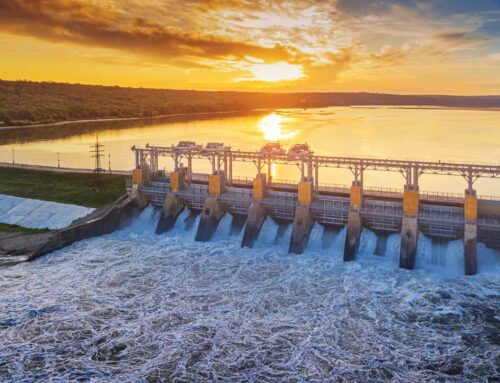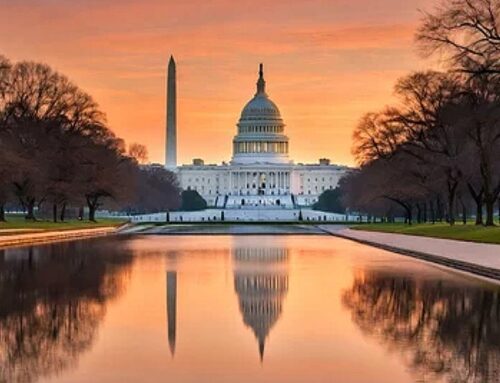NWC Federal Spotlight (Dec. 30, 2022)
Happy Holidays NWC members,
I hope your holidays have been going well. While the 117th Congress officially ends on Jan. 3, 2023, essentially they completed all of their legislative business before the Christmas holiday. This includes passage of a compromised Water Resources Development Act package and FY2023 appropriations (more below), both of which were promptly signed into law. Congress will be back to open the 118th Congress on Jan. 3, 2023.
Additionally, and probably the biggest news buried on the fourth line, the U.S. Environmental Protection Agency (EPA) and the U.S. Army Corps of Engineers unveiled its final “Revised Definition of ‘Waters of the United States’ rule which will be implemented 60 days after its publication in the Federal Register. How this final rule will fare, compared to the previous Obama and Trump rules, is anyone’s guess. And an added complication: the Supreme Court has yet to rule in Sackett v. EPA, a related case, they heard this fall.
Finally, I just wanted you to be aware that registration and the hotel block for NWC’s Legislative Summit on March 6-8, 2023, in Washington, DC has opened. Early bird pricing ends on Jan. 31, 2023 and the hotel block closes on Feb. 9, 2023 (or until the room block is full). For more information, click here.
As always, if you have any questions, please do not hesitate to reach out. Have a wonderful New Year and “see” you next week!
Best,
Julie
CONGRESSIONAL SPOTLIGHT
FY2023 APPROPRIATIONS SIGNED INTO LAW. On Dec. 29, President Biden signed into law the 4,155-page text of the $1.7 trillion omnibus appropriations package for FY2023 (H.R. 2617). Passed just before Christmas, the measure contains funding for all FY2023 federal appropriations bills through September 30, 2023.
Energy and Water Development
According to a committee summary, the Army Corps of Engineers would receive over $10.24 billion for FY2023, which includes $8.66 billion for USACE’s civil works program. The bill also includes $1.93 billion for the Bureau of Reclamation.
- Investigations – The bill provides $172.5 million for investigations.
- Construction – The bill provides $1.8 billion for construction, which includes $72.3 million for the Continuing Authorities Program.
- Operation and Maintenance – The bill provides nearly $5.1 billion for the Operations and Maintenance account, which includes additional funding to the National (Levee) Flood Inventory, which includes $3.1 million to expediate work on non-federal levees.
- Mississippi River and Tributaries: The measure includes $370 million for the Mississippi River and Tributaries account.
- Regulatory Program: The agreement includes $218 million for the regulatory program and instructs the Corps to use excess funds to address staffing shortages and processing of permits in a timely manner.
- Flood Control and Coastal Emergencies: This program receives $35 million for flood control and coastal emergencies under the bill.
- Water Infrastructure Finance and Innovation Program: The measure provides $7.2 million for the Water Infrastructure Finance and Innovation Program account for program development, administration and oversight, including but not limited to finalizing the proposed rule.
- Invasive Carp—The measure includes $226 million to stop invasive carp from reaching the Great lakes.
Additionally, the bill includes funding for the Bureau of Reclamation includes $186 million to fund Western drought programs under the WIIN Act. These programs fund long-term drought strategies including, water storage, water recycling and reuse, and desalination.
Resources:
- To read the legislative text of the Consolidated Appropriations Act, 2023, click here.
- To read the joint explanatory summaries, including bill summaries, click here.
- To view a fact sheet on the Energy-Water portion of the bill, click here.
CONGRESS FINALIZES WRDA 2022 AND SENDS TO WHITE HOUSE FOR SIGNATURE (Since this blog was written, the president has signed into law WRDA 2022—NWC thanks our consultant, Jon Pawlow, for sharing. Also, be sure to check out our final WRDA 2022 chart). The legislation, which is the fifth Water Resources Development Act (WRDA) in a row since 2014 to pass on a two-year cycle with bipartisan support, is critical for providing a plan for the U.S. Army Corps of Engineers (Corps) work on water resources projects for navigation, flood control, and ecosystem restoration around the Nation.
The House and Senate passed separate WRDA bills this past summer by wide margins in each chamber, evidencing strong support behind these bills. After several months of negotiations, House and Senate negotiators were successful in reconciling their respective bills, incorporating provisions from both bills in a final WRDA for 2022. [See the bill text.]
The House and Senate bills, to a reasonable extent, aligned with each other and, unlike recent previous WRDA bills, went relatively light on major, transformative, or hot-button policy proposals. The House and Senate bills also had considerable stakeholder and Member support going into the negotiations, in part because the bills would authorize numerous large, important water resources projects, included several significant regional priorities, and contained many individual Member-directed (so-called “earmark”) proposals for water resources and environmental infrastructure projects.
This all helped to minimize controversies surrounding the legislation and make it easier for the House and Senate negotiators to reconcile their respective bills.
Here are some highlights of the final WRDA 2022 legislation:
The final WRDA bill is very much an amalgam of the House and Senate versions passed earlier this year. The House and Senate bills had a fair amount of overlap, but there also were many different provisions that did not match. Nevertheless, most provisions from each bill got incorporated in some way into the final bill, thereby almost doubling the length of the final bill as compared to the House and Senate versions. There was only a handful of provisions in either the House or Senate versions that did not make it into the final bill.
- The final WRDA bill authorizes 25 new projects around the Nation that have completed the Corps’ technical review, including 5 for navigation, 6 for managing flood risk, 11 for hurricane and storm damage risk reduction, and 3 for ecosystem restoration. The total (Federal plus non-Federal) price tag for these projects is $50.4 billion. One of those projects is the massive $34.4 billion Coastal Texas Protection and Restoration project proposed for Galveston Bay. Other very large projects authorized include the $6.3 billion New York-New Jersey Harbor Deepening Channel Improvements project, 2 hurricane and storm damage risk reduction projects in Louisiana at a total cost of nearly $3.1 billion, a $2.7 billion coastal storm risk management system for the Florida Keys, a $1.7 billion project consisting of levees and floodwalls along the South Shore of Staten Island, and the $1.3 billion Charleston Peninsula coastal storm risk management project. These and the other authorized projects still will need Congress to appropriate funding.
- The bill contains authorizations for 94 new feasibility studies for future water resources development projects, and 12 studies to modify existing projects. In addition, it modifies 6 projects pursuant to pending Director’s Reports (also known as Post-Authorization Change Reports, or PACRs), which have been approved by the Corps, at a total cost of $11.8 billion. The bill contains directives for the Corps to “expedite” the completion of numerous designated projects and studies, including 25 feasibility studies, 2 PACRs, 2 authorized watershed and river basin assessments, and 1 determination related to the maintenance of a Corps navigation project currently underway.
- The bill also includes several significant regional priorities, among other things, pertaining to Western water supply, conservation, and drought issues, coastal Louisiana and other coastal areas, and Everglades restoration. These include provisions expanding the Corps’ authority to address the future water supply needs of communities, creating a Western Water Cooperative Committee charged with minimizing conflicts between Army Corps projects and state water laws, and authorizing a number of studies to evaluate facilities in Western states and to find efficiencies at Corp reservoirs.
- Notably, the bill adds numerous individual Member-directed proposals for water resources and environmental infrastructure projects, including the authorization of over 100 new environmental infrastructure authorities, and modifying 23 existing environmental infrastructure authorities, for a total of almost $6.6 billion in environmental infrastructure assistance for community-driven projects and state-wide infrastructure programs carried out in partnership with the Corps throughout the Nation.
- The final WRDA bill contains various bipartisan provisions to boost the Corp’s ability to address sea-level rise, shoreline erosion, and the threat of increasingly extreme weather . The bill directs the Corps to study and map coastal land changes; expands feasibility studies to incorporate other flood risks and include water supply, water conservation, and measures to reduce water resource impacts of extreme weather events, including drought; authorizes the Corps to perform up to 10 feasibility studies (at 90 percent Federal cost) of managed aquifer recharge projects; prioritizes beach renourishment; extends for 15 years periodic renourishment for projects that have reached their maximum authorized renourishment period; reauthorizes some of the Corps’ levee authorities; and allows the Corps to not only repair and restore non-Federal hurricane, shore protection, and other flood control structures to their original design, but to address deficiencies and enhance their resilience beyond their original design to make communities more resilient. The bill also amends a non-Federal levee repair authority to increase the Corps’ per-project assistance limit from $10 to $25 million, and to prioritize assistance for economically disadvantaged communities.
- WRDA 2022 includes a policy provision that makes permanent the 65-percent general revenues/35-percent Inland Waterways Trust Fund (IWTF) cost-share for lock and dam construction and major rehabilitation projects, which was first established in WRDA 2020. The cost-share provision was set to expire in 2031 (at which time the cost-share would return to the former 50/50 split). It is hoped that the 65/35 cost share will help IWTF revenues finance more projects than under the previous 50/50 cost-share.
- A section of the final bill requires the Corps to track and provide an annual report to Congress on time frames for completing National Environmental Policy Act (NEPA) reviews for water resources development projects, to help assess and get a better accounting of how long it takes for water projects to navigate permitting requirements.
- Other provisions in the bill aim to boost tribal representation, outreach, and assistance, including a provision that requires the Corps to establish an advisory committee on tribal and economically disadvantaged communities, and language for the Corps to increase outreach to underserved communities regarding partnerships and resources.
A couple of potentially controversial provisions in the House or Senate bills did not make it into the final WRDA bill, including:
- A provision in the Senate bill dealing with a shoreline and riverbank protection and restoration mission, which had the potential of being interpreted as changing Corps policy by elevating the protection and restoration of shorelines, riverbanks, and streambanks as a new, top priority Corps mission over the Corps’ traditional navigation, flood control, and ecosystem restoration missions.
- A provision in the House bill related to a series of dams along the Lower Snake River in the State of Washington, which generated concern among some tribes and environmental interests that the provision could exclude tribes from discussions over the dams’ future.
There was some question of how and when the final WRDA 2022 bill would reach the finish line this year, but ultimately it hitched a ride with the National Defense Authorization Act for Fiscal Year 2023 (NDAA) to pass out of Congress and go to the White House for the President’s signature. [See NDAA bill; WRDA 2022 is in Division H—Water Resources, TITLE LXXXI—Water Resources Development Act of 2022 of the NDAA bill.] The President is expected to sign the bill.
Enactment of WRDA 2022 will be good news for the Nation. WRDA bills deal with the Nation’s water resources infrastructure managed by the Corps. The Corps’ missions, and its associated water resources infrastructure around the Nation, are vital to promoting our Nation’s economy, prosperity, and national security through the development, management, protection, and enhancement of the Nation’s water and related land resources for flood damage reduction, commercial navigation, environmental restoration, and allied purposes.
FEDERAL AGENCY SPOTLIGHT
FINAL WOTUS RULE RELEASED. On Dec. 30, 2022, the U.S. Environmental Protection Agency and the U.S. Army Corps of Engineers announced the final “Revised Definition of ‘Waters of the United States'” rule which will be effective 60 days after it is published in the Federal Register. As part of this rule, the agencies also are releasing several implementation determination memos. First, EPA and Army are issuing a joint coordination memo to ensure the accuracy and consistency of jurisdictional determinations under this final rule. Second, the agencies are issuing a memo with U.S. Department of Agriculture to provide clarity on the agencies’ programs under the Clean Water Act and Food Security Act. NWC is currently analyzing this rule.
According to an EPA/USACE fact sheet, the following waters are jurisdictional:
- Traditional Navigable Waters (a)(1)
- Territorial Seas (a)(1)
- Interstate Waters (a)(1)
- Impoundments (a)(2)
- Tributaries (Tributaries are jurisdictional if they meet either the relatively permanent standard or significant nexus standard) (a)(3)
- Adjacent wetlands (Adjacent wetlands are jurisdictional if they meet either the relatively permanent standard or the significant nexus standard, or where the wetland is adjacent to a traditional navigable water, the territorial seas, or an interstate water) (a)(4)
- Additional waters (These lakes, ponds, streams, or wetlands do not fit into the above categories. They are jurisdictional if they meet either the relatively permanent standard or the significant nexus standard) (a)(5)
As with previous WOTUS rules, legal challenges are expected. Additionally, there is a related case pending in the U.S. Supreme Court, Sackett v. EPA, which the court is expected to release a final decision in early 2023. Specifically, the court will assess the limits of federal authority over wetlands and other waterways, including what tests should be used to determine a “Waters of the U.S.” under the Clean Water Act (CWA). The Sackett’s case began in 2007 after the U.S. Environmental Protection Agency stopped construction of a house the Sacketts were building because the plot of land contained a wetland. The agency ordered them to get a Section 404 permit for the construction or face a $30,000 a day fine. When the Sacketts tried to challenge EPA’s compliance order, they were told they couldn’t. In 2012, their case reached the Supreme Court who ruled that the Sacketts could in fact challenge EPA’s order. Since then, EPA has dropped the order but is adamant that the Sacketts should be required to get a Section 404 permit for the construction. Last year, the 9th Circuit Court of Appeals ruled against the Sacketts stating that the land in question was a jurisdictional wetland under Justice Kennedy’s 2006 “significant nexus” test in Rapanos v. United States.
The term WOTUS has been around since the 1899 Rivers and Harbors Act but in 1972 was added to the Clean Water Act to differentiate between which waters are regulated at the state versus federal level. In recent years, due to several controversial Supreme Court decisions, the WOTUS definition has become increasingly murky, leading to confusion in the field about what is and is not a WOTUS. The past several administrations have attempted to redefine WOTUS but have run into legal challenges. During the Trump administration, they rewrote the WOTUS rule finalized under the Obama administration, however, that rule ran into legal challenges. In August 2021, Trump’s Navigable Waters Protection Rule was struck down by a federal district court in Arizona. In response, the EPA and USACE reverted to their previous 1986 definition (with amendments) as they worked to rewrite this rule, which will replace the 1986 definition. NWC submitted substantial comments on the proposal to replace the 1986 regulations (Feb. 2022).
Resources:
- To read the final WOTUS rule, click here.
- To read a fact sheet on the final rule, click here.
- To read the Memorandum to the Field Concerning Issues Related to Implementation of Section 404 of the Clean Water Act (CWA) and the Food Security Act of 1985, as Amended (FSA) (“2022 Ag Memo”) on federal wetland programs and prior converted cropland, click here.
- To read the Memorandum to the Field on Exemptions from Regulation under Section 404(f)(1)(C) of the CWA for the Construction or Maintenance of Irrigation Ditches and for the Maintenance of Drainage Ditches (“2020 Ditch Exemptions Memo”), click here.
- To read the memo on Waters That Qualify as “Traditional Navigable Waters” Under Section (a)(1) of the Agencies’ Regulations (“TNW Guidance”) (formally known as Appendix D), click here.



